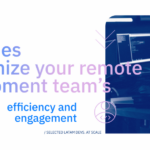Have you decided to work with a remote dev team in Latin America? Then you’ll need an official remote work policy that will allow you to set expectations, align your developers, and prevent critical errors.
Still not sure what your policy should cover? Don’t worry; we prepared a checklist with everything that you should include.
What is a remote work policy?
Let ‘s start with what it’s not: a remote work policy is not a series of informal recommendations that are spread through the grapevine between managers and team members. It’s not a list of points that you mention in passing during the onboarding process and hope that they take note of them and put them in practice.
It ‘s important to clarify this because any kind of company policy must be a formal document of standards that have the same validity as a contract and clauses for practical purposes. That way all employees know what’s expected of them and what they can expect from their employer.
Your company might already have a set of in-person work policies, but work that involves software development with a remote team generally needs its own rules. These are set in order to adapt agile methodologies and topics related to information and asynchrony to a remote work style.
To start, you’ll need to create an overall framework or general draft of your remote work policy and take the following basic elements into account:
1.- Schedules, Goals and Objectives
The first question you need to ask is whether the work days will be determined by the number of hours effectively worked or by achieving daily or weekly objectives. If you choose a more objective-driven approach, it’s important that the goals are realistic and reachable in a reasonable amount of time that doesn’t impact your team’s work-life balance.
If you prefer working by the number of hours, it’s important to determine how you’re going to monitor your devs’ productivity while they’re working, if they’ll have a strict schedule with breaks at specific times, or if they can choose how their time is organized.
You’ll also need to specify the response time that you expect from your devs. For example, you might ask that they answer a question from the project leader within 30 minutes during the work or synchronous schedule.
2.- Hardware, system, and tool requirements
What are the minimum requirements that the team has to cover while working with your devs? What programs and versions do they need to install? What cloud collaborative work platforms do they have to sign up on? Will the company take care of paying for a few work tools and/or licenses, or will your collaborators be responsible for them? How will reimbursements and overall payments for the post be handled?
3.- Security and confidentiality
One of the few disadvantages of working remotely on programming projects is that the information and security can be much more vulnerable when you don’t have control over all the networks that your systems and servers are connecting to.
It’s important to consult a cybersecurity expert on good practices for your entire team to follow. This can include backing up daily progress, using a VPN, protecting meetings with a password, or avoiding the use of personal devices or public networks to access the platform.
4.- Workflows
This section answers the question: “How are we going to integrate our work with everyone else’s to create productivity and efficiency synergy with the entire team?”
Your devs can be incredibly talented. But if you don’t make sure that they all follow the same communication, approval, and progress update protocols in a predictable manner, misunderstandings and delays due to a lack of task updates are nearly inevitable.
5.- Managing problems and contingencies
When does a team member have to check the FAQ and resource library to solve a problem, and when should they take the problem directly to the project leader? Who should they go to if they see a security breach at a time when the rest of the team isn’t working? What should they do if there’s a DNS block on the server? Should they update their IP or report the incident?
Being prepared to face the unexpected is especially necessary for remote work situations where nobody can just get up from their desk and escalate the situation with a superior.
6.- Performance evaluation
Whether your team works by the number of hours, by objectives, or a mix of both, real performance isn’t necessarily equivalent to the amount of time that someone spends programming or the number of deliverables that they delivered. It has to do with efficiency, the quality of the code, and with preventing errors.
Your devs need to have a clear understanding of how you’re going to evaluate their performance and how you’re going to monitor their work. For example, a time tracker can tell you that a programmer achieved the same productivity as another during the week but had to spend 30% more time to achieve it. This means that while the results were similar, the performance was lower.
7.- Working environment
Your remote work policy also has to cover topics related to the company culture for software development projects, like the image that’s projected by representing the company, tolerance, respect, unacceptable forms of communication, and whether or not team building activities are required, nice to have, or optional.
Once you have the more general aspects covered, the next step is to have every department in the company that will work with the remote development team, for example IT and Human Resources, add any points that you might have missed, and finally break down the information in an extremely detailed way in order to create the current version of your remote work policy.
Remember that this document has to be signed by all of your devs during the onboarding process. You can always make changes to it in order to accommodate the company’s needs, but you’ll need to notify your team of these changes in advance and have everyone agree to these changes in writing.
Once you finish perfecting the remote work policy that your company needs to keep scaling their productivity, it’s time to find the best candidates and build your remote programmer dream team! At Workana, our talent pool is composed of Latin America’s most elite and highly-qualified devs and we offer the only seven-day risk-free trial on the market so you can see the impressive quality of their work for yourself. Let’s get started!
You may also be interested in:








